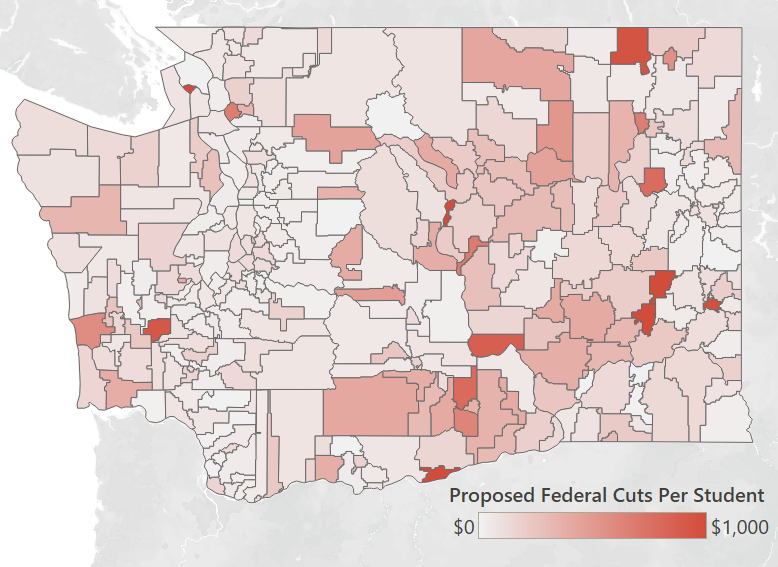Media Contact
Katy Payne she/her
360-764-0201
Last Friday, President Trump released his proposed federal budget, which included broad cuts to K–12 education programs. Below is State Superintendent Chris Reykdal’s statement.
OLYMPIA—June 5, 2025—The Trump Administration has been adamant from the time of his campaign that the U.S. Department of Education must be eliminated. What has been less clear is how the President and his administration truly view the broader issue of federal funding for K–12 education and the long-standing, significant federal investments that support students. Last Friday, he released his proposed budget, making his stance on this very clear.
While keeping key programs largely intact, such as Title I (support for high poverty districts) and the Individuals with Disabilities Education Act (IDEA), the President dramatically reduced or completely eliminated several other programs that serve marginalized student populations and support students in their learning and educational success. It is no secret that school privatization efforts start with the elimination of supports for historically underserved students. The President’s actions, and now his proposed budget, reinforce this effort.
Among the programs eliminated are Title I, Part C (Migrant Education Program) and Title III, Part A (English Language Acquisition). Several other programs are combined and reduced by 70%, including Title II, Part A (professional learning for educators), Title IV, Parts A and B (before- and after-school programs and other programs that promote equity in education), students experiencing homelessness (McKinney-Vento), school safety grants, support for at-risk youth in institutions, and more. Additionally, school meals funding provided through the U.S. Department of Agriculture appears to be reduced. If this budget were to be adopted as is, the amount of essential funding that would be pulled from Washington’s school districts totals to over $100 million per school year.
The power of public education is that we serve any student who walks through the door. Public schools embrace each student’s uniqueness and help them meet their potential as learners and citizens. Cuts of this magnitude and with this focus on students who rely on additional support from the hard-working and passionate educators who serve them, is yet one more signal that this administration’s focus has little to do with the reality of student needs.
Below is a map of a very high-level look at cuts per full-time equivalent (FTE) student by school district if this budget proposal were to be adopted as is. The map shows funding levels from the 2023–24 school year, with one-time emergency relief funds removed, as an estimate of the funding school districts would lose if the proposed budget was adopted. The map uses color gradients to indicate levels of potential federal funding cuts, with darker shades representing larger cuts per student and lighter shades representing smaller cuts.

The map tells a clear, and concerning, story—President Trump’s proposed budget would result in sizable impacts on the students and schools in rural communities. While some of the total dollar amounts are smaller in rural communities, those dollars as a percentage of their budgets is much larger. The dependence of our rural communities on the federal government has always been larger than in urban areas, and the proposed cuts demonstrate this outsized impact. Schools in rural areas are often community “hubs”, and budget cuts of this size have the potential to be absolutely devastating to communities and families around the state.
The Trump Administration’s proposed budget is an outline of the Administration’s priorities and still requires congressional approval. While the U.S. House of Representatives appears ready to make the changes requested, the U.S. Senate has provided much less clarity on their priorities. As budget deliberations continue throughout the summer, my office will continue to be very engaged in advocacy for adequate and impactful funding for our students and schools in all parts of our state.
Let me be clear—I am supportive of changes to federal programs in the name of government efficiency if there is a better, sustainable, and data-driven program to replace them. By targeting and eliminating programs that directly support students, without establishing a “back-up plan”, the Trump Administration is being intentionally reckless in order to tear apart our public education system, while simultaneously harming our most vulnerable students and families.
Public education is the primary driver of our young peoples’ futures and our economy, and it is absolutely the foundation of our democracy. President Trump’s proposed budget, alongside several other dangerous and chaotic actions he’s taken during his presidency, make very clear that it is his intention to harm public education and the opportunities it provides to nearly 90% of America’s students. I refuse to back down from this fight—for our 1.1 million amazing students, their families, and their educators—and for the future of our country. This is not a partisan issue or limited to one program. This is our entire public education system under attack by an extremist ideology.
For More Information
Proposed Federal Cuts to K–12 Education Map (published June 5, 2025)






